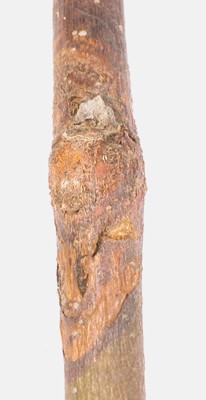Diseases
Cryptosporiopsis curvispora (Peck) Gremmen. - Anthracnose Canker on Apple
Systematic position.
Division Ascomycota, class Ascomycetes, order Helotiales, family Dermateaceae, genus Cryptosporiopsis.Biological group.
Biotroph.Morphology and biology.
Anthracnose Canker on Apple is most abundant on smaller branches, but can appear on larger limbs or on trunks of young trees. Complete girdling is often observed, if more than one canker is present on a limb. The first apparent sign of the infection is the formation of a small circular reddish brown spot on bark extending to the underlying tissues. Development of these cankers is arrested during winter. The canker expands most rapidly along branches in spring. The cankers cease to extend, and a well-marked crack forms, delimiting the canker from the surrounding healthy tissue. The surface of the canker becomes shrunken and shriveled as surrounding tissue continues to grow during summer. Dead tissue gradually disintegrates and falls out. It remains often at wound for several years, forming "fiddle strings" across the longitudinal face of the canker. During summer, numerous small pustules (acervuli) appear on the canker's surface, first at the center of the area and later at its margin. Cankers of the 1st or more year old are not enlarged, but being a fruitful source of the fungus conidia. Conidia are oblong, bended, aseptate, colorless or greenish, 11.5-35x3-6 mkm. On fruits the disease shows first as brown depressed circular spots in storage. As a spot extends, the fungus fruiting bodies (acervuli) develop in its center, often in concentric rings, which gives the name "bull's-eye" to the rot.Distribution.
Anthracnose Canker on Apple is distributed in Kursk, Pskov, Samara, and Leningrad Regions of Russia, in Latvia, Estonia, Ukraine, Azerbaijan, and Georgia.Ecology.
The fungus spores mature at late summer and early fall, being spread by rain and wind. Optimum temperatures for germination of conidia are 16-27.C.Economic significance.
Infected fruits become unmarketable. Limbs girdling by cankers eventually cause killing entire branches. Control measures are various, including use of resistant cultivars, sanitation of orchards, and chemical control.Related references:
Aliev D.G., Gyandzhaliev G. 1973. Studying etiology of diseases drying-up seeds of fruit cultivars under conditions of Kuba-Khachmass zone of Azerbaijan USR. In: Anon., ed. About reason of drying-up of fruit trees in republics of Transcaucasia. Baku: Transcaucasian Department of VASKHNIL, section of plant pathology. P. 3-4 (in Russian).James P.W., Hawksworth D.L. 1971. Ainsworth & Bisby.s dictionary of the fungi. 6th edition. Kew: CAB, 663 p.
Khokhraykov M.N., Dobrozrakova T.L., Stepanov K.M., Letova M.F. 2003. Keys to plant diseases. Saint-Petersburg: Lan', 592 p. (in Russian).
Lepist A.Ya. 1969. Anthracnose of apple in Estonian USR. Mikologiya i fitopatologiya (Leningrad: Nauka) 3(4): 335-337 (in Russian).
Martsikh Zh. G. 1965. Pathogenic fungi causing diseases of branches of apple and pear trees. In: Anon., ed. Infectious diseases of arable plants in Moldova. Kishinev: Kartya Moldovenyaske, p. 29-40 (in Russian).
Mel.nik V.A. 1997. Keys to fungi of Russia. Class Coelomycetes. S.Petersburg: Nauka, 279 p (in Russian).
Minkevich I.I., Potlaichuk V.I. 1965. Infectious withering of fruit crops. Leningrad: VASHNIL, VIZR, 22 p. (in Russian).
© Bilder I.V.


